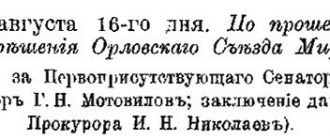During the consideration and adjudication of a criminal case, it may be necessary to seize the property of the defendant. This measure is used if it is necessary to obtain guarantees that the convicted person will be able to compensate for damage to the injured party - another person, state or legal entity. Seizure of property is also used when it comes to material evidence in criminal proceedings.
In the article we will consider the rules of this procedure, which objects can be subjected to it, as well as other features of the process. To discuss a non-standard situation, we recommend that you seek advice from an experienced specialist.
Do you want to figure it out, but don’t have time to read the article? Lawyers will help
Entrust the task to professionals. Lawyers will complete the order at the cost you specify
150 lawyers on RTIGER.com can help with this issue
Solve the issue >
Seizure of property: reasons and purposes
The main purpose of seizure of property is to force the offender to fulfill the obligations imposed by the court verdict. This term means that the owner is deprived of the right to use certain material assets. During the consideration of a criminal case, the seized property may be confiscated, for example, if it was obtained as a result of criminal acts and fraudulent machinations.
A seizure of property can be imposed even before the start of the trial by the relevant body that is handling the case. Article 115 of the Criminal Procedure Code of Russia (Code of Criminal Procedure of the Russian Federation) indicates all the rules and features of the application of the procedure for arresting real estate and other material assets.
The most common reasons why courts grant an investigator’s request to seize property:
- Consideration of a criminal case. In this case, the restriction on the use of property is used as an incentive that may encourage the defendant to fulfill his duties towards the injured party.
- Causing material damage to the state, legal entity or individual. The use of property seizure helps to fully or partially reimburse the cost of damaged property and compensate for the losses of the injured party. It is worth noting that the court does not have the right to confiscate the material assets of the perpetrator of the crime if their value is higher than the damage caused.
- A dispute arises between several property owners. This situation usually arises with real estate and cars that are inherited. Participants in the process will not be able to use the property until the hearing of the case is completed. An alternative option is to negotiate a solution yourself.
- Debt to the tax service or other government agency. Material assets are used as collateral. They guarantee that the debtor will fulfill his obligations in any case.
It is worth separately explaining the rule on the proportionality of property recovery, which was mentioned in the second paragraph of the list. The Supreme Court of Russia commented that by law it is impossible to seize property if its value is higher than the damage caused or the maximum fine specified in the article of the Criminal Code of Russia (CC RF).
In this case, the investigator can limit the request only to a proportionate part of the defendant’s property. Let's look at the rule using a clear example.
Ivanov N.K. accused of official forgery, for which a fine of 100 thousand to 500 thousand rubles is provided. The investigator comes to the trial with a demand to seize the defendant’s car, the cost of which is estimated at 1.5 million rubles.
The court will refuse the request for several reasons: confiscation cannot be applied to the car; its price tag is higher than the maximum possible fine; partial seizure of the designated object is impossible.
A similar decision will be made if the civil claim claims an amount of 73,000 rubles, and the value of the real estate for which the seizure is requested is 2.1 million rubles.
Only a judge and a bailiff have the right to seize property. The legality of the process is confirmed by the act, which serves as the starting point for the commencement of enforcement proceedings on the designated issue.
How to carry out the procedure
If during an investigation or trial it is necessary to carry out a procedure for seizing property, then the procedure is carried out by the investigator who is in charge of the case and acts as a prosecutor.
To begin with, determine the amount of property that is in the possession of the criminal. To do this, submit appropriate requests to Rosreestr, cadastral registration, traffic police authorities, and banks where funds may be located.
If a corresponding volume is identified, the investigator goes directly to the location of the property and seizes it, provided that this procedure can be carried out.
When seized, a special act is drawn up, which will reflect the data of the seized property, its distinctive features, if any, the place where these items will be transferred, and a person responsible for storing these items will be appointed.
Property storage options:
- remains in the custody of the debtor;
- transferred to the warehouse to law enforcement agencies;
- kept in case if it is small in size (disk, key, document, etc.).
If it is decided to leave things for safekeeping to the owner, then the responsibilities for preservation are briefly announced to him. Typically, the length of the garnishment depends on the progress of the investigation and the rendering of a decision or until the repayment of the awarded material amount. During this period, it is prohibited to try to sell, exchange, gift or perform other actions with it. You can use things, but with care, preventing intentional damage to things.
If property is transferred to a warehouse, it is sorted. First of all, cash savings, securities, products made of precious metals, antique furniture and antique paintings, burnt-out equipment, such as a television, are confiscated. These products are placed in specially protected conditions. If no one lives in it, the property is sealed. Vehicles are parked in open parking.
Items can be transferred to responsible persons for storage. This is rarely done. But if before the criminal case the real estate was leased and the owner is the lessor, then the contract is not terminated if it is for a period of no more than a year. It remains in force, and a custody agreement is concluded with the tenant.
The cessation of application of this restriction depends on the extent to which this measure is required. If its necessity no longer exists, then it is canceled according to a special form of resolution. Such a decision can be issued only by the investigator or the court that imposed this restriction.
If they refuse to lift the arrest, even if there is no need to use it, then the defendant has the opportunity to file a complaint against the actions of the body that limits the exercise of his rights without any reason.
Another person may file an appeal against the decision to lift restrictions if he or she was affected by this matter.
If the person responsible for preserving the property fails to fulfill his obligations properly, he may be held accountable and become a defendant, since he assumed certain obligations that he fulfilled improperly.
What property can be seized?
The law allows seizure only to certain categories of property. The procedure for confiscating and limiting the use of material assets should not violate basic human rights and freedoms. The following property may be seized:
- Bank and other accounts with financial companies. The funds will be used to fully or partially repay the debt.
- Securities. Seizure is used when there is a large debt. The owner has no right to use, donate, or sell them. The type and value of securities is determined by a court decision.
- Debts of third parties to the offender. Government authorities can seize all funds that enter the defendant's bank account. They immediately go to pay his debt.
- Trading account for transactions with currencies, shares and securities on a specialized market.
- Real estate. The seizure of real estate can be implemented in two ways: a complete inventory of the property or a ban on its use.
- Movable property such as a car, furniture, precious stones and metals. In most cases, due to its low price, it is seized in addition to more expensive property.
It is important to remember about objects that the court does not have the right to seize. First, the property must belong to the suspect. Seizure is also possible if it is obvious or proven that other persons acquired real estate or other valuables using funds that the accused received in the course of criminal acts.
Example: Kirilenko I.S. accused under the article “Fraud on a large scale.” During the investigation, it was revealed that his relatives purchased the hotel to hide the income of the accused. As a result, the commercial property was seized.
The property that is most often seized is real estate. But the procedure becomes impossible if the apartment or house is registered as the only place of possible residence of the accused and his family.
Property that is not subject to seizure includes personal belongings (household items, clothing), food, pets, and state awards.
Basic provisions of property seizure
The seizure of property within the framework of a criminal case is carried out for the purpose of its safety, so that the compensation for material damage cannot realize it and thereby prevent the bailiff services from making compensation under the writ of execution.
This procedure is carried out within the framework of a criminal case; the initiator of the arrest can be an investigator, a judge or the injured party.
Before the procedure, the actual existence of any property of the defendant is established, the property that according to the law cannot be sold is determined, then procedural actions with housing and other types of valuables follow, prohibiting the owner from alienating them.
It is worth noting that a person can have 2 types of values:
- Movable.
- Real estate.
Movable property is distinguished by the fact that it can be easily moved by anyone to any place. When drawing up a protocol for these measures, things of this kind are transferred for safekeeping to the owner of the property. Exceptions include particularly valuable items, as well as money and securities.
There may be a situation in which such things must be transferred for safekeeping to bailiffs. In this case, everything seized is kept in a special warehouse until the writ of execution is received by the FSSP (Federal Bailiff Service). The seizure is formalized by a special protocol, which indicates the address of the storage location.
Real estate cannot be seized due to its large weight or specific location on earth; restrictions on transactions with it are established. The court issues a special resolution for Rosreestr, whose employees make a corresponding note about the decision. The encumbrance will be lifted after all financial obligations have been repaid. When such a mark is in effect, the property cannot be alienated under any agreement.
Accounts containing funds are also blocked. A seized account cannot be unblocked until the case is resolved. Next, the collection sheet is submitted to the FSSP; if the defendant pays the funds on his own according to this document, then his account will be unblocked. If such actions do not occur, then the money will be withheld for payment under the document. In practice, seized funds in the account are often written off by bailiffs to pay off the writ of execution.
After full repayment and elimination of all the reasons for which the ban on registration actions is applied, the court or bailiff issues a resolution that removes the encumbrance from the Rosreestr authorities and allows the owner to alienate the property.
What restrictions does it provide?
What exactly are the restrictions? What the person whose things were described cannot do:
- prohibition on disposal. You cannot sell, give, exchange, rent, or pledge;
- prohibition to use a seized item. For example, a car on which a coercive measure was imposed was prohibited from using. That is, drive a car, navigate public roads
- withdrawal of value with or without transfer to an independent person for storage.
All of the above does not mean that the owner was deprived of the title of owner. Only his powers are curtailed and additional obligations are introduced. Let’s say that a disposal ban has been placed on an item, leaving it with the owner with the opportunity to use it for its intended purpose. At the same time, they are strictly admonished to protect it from damage and death.
For how long does the measure apply?
Most often, the period for seizing the property of the accused is equated to the period for the preliminary investigation, plus the period for bringing the case to court. That is, the deadline is set not by dates, but by the stages of the investigation.
For example, there is the following phrase “….until the preliminary investigation is completed and the case is transferred to court.”
Some investigators in their petition determine the exact dates until which property coercion will be in effect. This date is calculated offhand, taking into account the predicted duration of the investigation.
But there are petitions from the investigator and decisions from the judge, where the issue of arrest periods is omitted. That is, there is no mention of this at all.
This is a gross violation, such a decision can be appealed on the specified grounds. Which will be enough to cancel it.
Extension
Extension of seizure of property in criminal law occurs in 2 situations:
- when the initial period of the compulsory measure during the preliminary investigation has expired. The procedure takes place in a court session in the presence of the participants in the case;
- The investigation was completed and the case went to court. At the first court hearing, the judge, on his own initiative, decides the fate of the property sanction, about which he issues a separate judicial act.
Is there a threat of criminal liability for debts?
Most often, late payments and debts are subject to civil liability. It consists of collecting debt through the court, charging penalties, penalties, and fines. In some cases, property may be taken from the debtor for debts.
Failure to pay a debt may result in criminal liability only for the offenses specified in the Criminal Code of the Russian Federation. When concluding contracts and making transactions, the parties themselves cannot establish the grounds for initiating a criminal case. All conditions for prosecution are specified in the Criminal Code of the Russian Federation. Explanations on the application of articles of the Criminal Code of the Russian Federation can be found in the practice of the Supreme Court of the Russian Federation.
Several important nuances related to criminal prosecution for debt obligations:
- a criminal case for debts can be initiated only against an individual
- if a debt has arisen from an enterprise, then the manager, chief accountant, and other officials can be tried for intentional guilty actions; - Punishment for a crime related to non-payment of debts can only be imposed by a court
- in this case, the Ministry of Internal Affairs, bailiffs, and officials of the Federal Tax Service have the right to conduct an inquiry or investigation into such criminal cases; - bringing to liability under the Criminal Code of the Russian Federation does not relieve one from the obligation to repay the debt
- collection is allowed under a civil claim in a criminal case, which the injured party has the right to file.
A criminal case can be initiated only if there is guilt in non-repayment of the debt. If the delay is caused by valid reasons or circumstances beyond the control of the citizen, then there will be no grounds for initiating a case. These points will be checked during the inquiry, investigation and trial.
They can be held accountable for debts at the request of the victim. For example, this could be a lender or creditor, a recipient of alimony. If damage is caused to the state, the relevant departments will submit a statement on its behalf. For example, for deliberate and malicious evasion of taxes, a case is initiated at the request of the Federal Tax Service. Therefore, in every criminal case there will definitely be an injured party.
For what debts can a criminal case be initiated?
There are several articles in the Criminal Code of the Russian Federation that provide for liability for debts. The case may be initiated:
- for evasion of repayment of accounts payable confirmed by a court decision;
- for systematic delay in alimony payments, but if the debtor has previously been brought to administrative responsibility;
- for tax debts of an individual or legal entity.
To initiate a criminal case, it is not enough to prove guilt in creating a debt. The size of the debt is also of great importance. Until it reaches a large size, they have no right to prosecute under the Criminal Code of the Russian Federation. The exception is alimony obligations, where it is not the size of the debt that is important, but the period of delay.
There are several other compounds that are indirectly related to debt obligations. For example, a case may be filed for credit fraud. In this case, we are talking about the deliberately illegal receipt of a loan without the purpose of returning it. In this case, money for an illegally issued loan will be recovered through a civil claim in a criminal case.
Conditions for criminal prosecution
To impose a criminal penalty, the investigation and the prosecution will have to prove the elements of a crime. Articles of the Criminal Code of the Russian Federation for non-repayment of debt provide for the following elements of a crime and conditions for bringing to justice:
- the fact of debt formation
- it is confirmed by court decisions, materials of the criminal case; - amount of debt
- according to the Criminal Code of the Russian Federation, punishment will be imposed only if the debt is large (with the exception of alimony); - maliciousness and deliberate evasion of debt repayment
- this means that the citizen had a real opportunity to repay the debt at least in parts, but deliberately avoided doing so; - the fact of bringing to administrative responsibility
- this sign is important only for criminal liability for alimony debts.
Criminal liability threatens for debts on credits and loans, taxes and alimony.
A criminal case can be initiated for debts of 2 million 250 thousand rubles, and for tax arrears - from 2 million 700 thousand rubles. For debts on alimony, criminal punishment threatens if there is a delay of two months, if the defaulter was previously brought to justice under the Code of Administrative Offenses of the Russian Federation.
In the articles of the Criminal Code of the Russian Federation one can find such a concept as qualifying characteristics. These are special conditions under which the punishment will be more severe. For example, such signs are in Article 198 of the Criminal Code of the Russian Federation for tax delinquency. Different sanctions are applied for large or especially large tax debts.
Amount of debt for criminal liability
How much debt can be subject to criminal liability? On this issue, the articles of the Criminal Code of the Russian Federation say the following:
- for malicious evasion of payment of accounts payable, the delay must exceed 2 million 250 thousand rubles. (large size);
- for tax debts they can initiate a case if there is a delay of 2 million 700 thousand rubles. (for three consecutive financial years);
- for alimony debt, its size does not matter, since the case is initiated on the basis of systematic non-payment (more than two months in a row).
The amount of accounts payable must be confirmed by a court decision that has entered into force. Tax delinquency is confirmed by declarations, calculations and other documents. At the same time, a tax debt can be recorded based on the fact of failure to submit a declaration or calculation.





